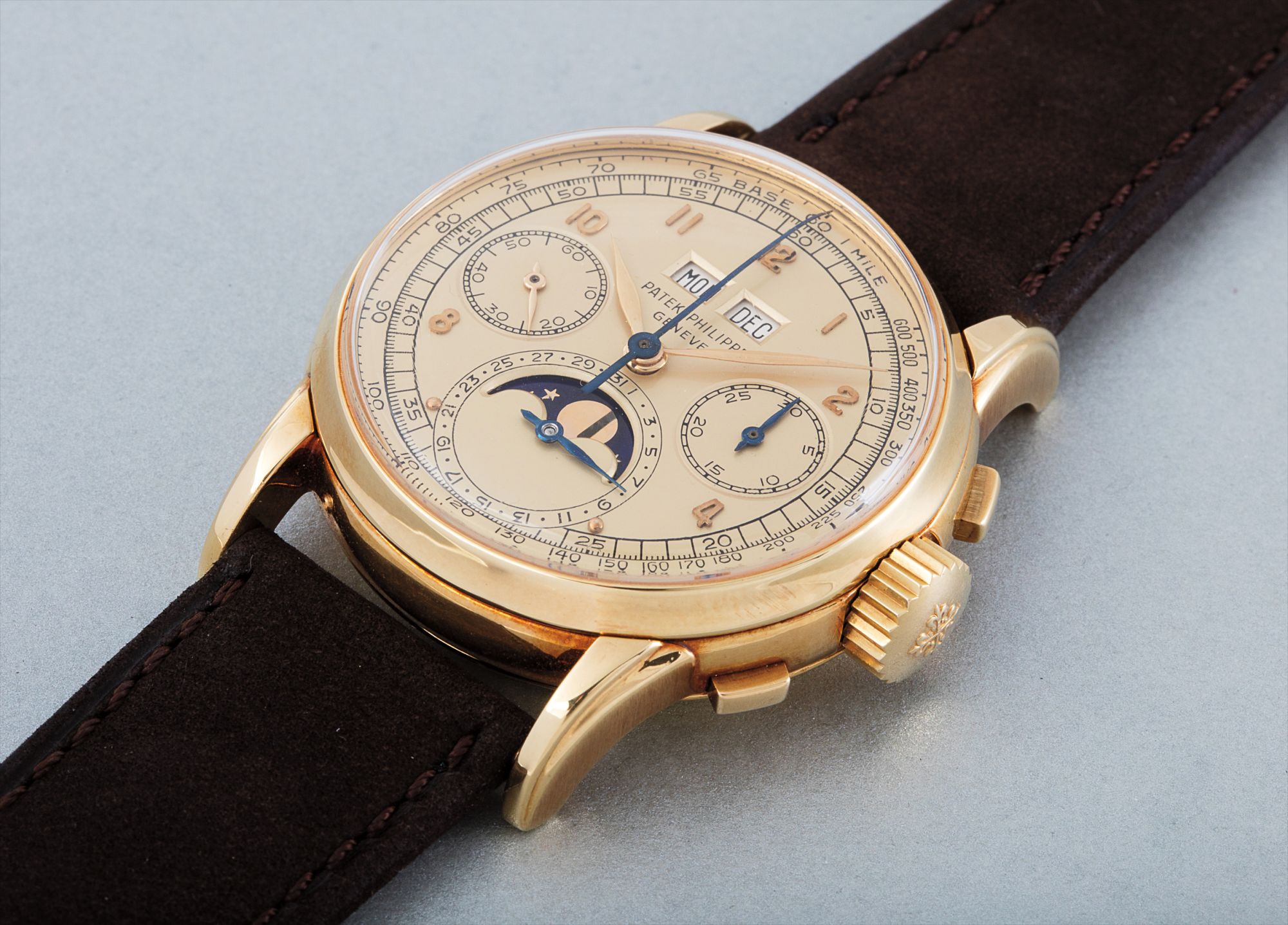

254Ο
Patek Philippe
Ref. 2499
An extremely rare and highly important yellow gold perpetual calendar chronograph wristwatch with moon phases and champagne-colored dial
Full-Cataloguing
Although the newly introduced reference 2499 was an incredible evolution for the firm’s top-of-the-line model, it also kept various very important technical and aesthetical elements of its predecessor, notably the movement, the square pushers and most of the dial design. The first generation reference 2499 left the firm’s workshops with Arabic numerals and a tachometer scale on the outer section of the dial. The most noteworthy element that was new to this flagship model was the case design, and in particular the lugs. Instead of being smoothly integrated into the case, like with reference 1518, they were now much more in the spirit of the 1950s. There design can be described as voluptuous and nearly baroque, as they were now prominent sculptures attached to the case and works of art in their own right. The lugs became a signature design element for most of Patek Philippe’s complicated watches to last over half a century, across numerous references and complications.
Interestingly, Patek Philippe chose Vichet to make the brand new reference 2499, but then, shortly after, switch to Wenger. The Vichet cases are known to have more pronounced and elongated lugs than those produced by Wenger. Also, the early Vichet cases have flat domed casebacks, resulting in the watches resting on its four lugs when put flat on a table, like a contemporary work of art. Vichet produced yellow gold and pink gold cases for reference 2499, and both case versions were made in exceedingly rare quantities. In fact, we know today of only four examples of rose gold 2499’s with Vichet cases, which today are considered amongst the ultimate trophies for any uber collector. Yellow gold examples are similarly rare, in fact we know not even of the existence of ten yellow gold examples with the Vichet case. The present watch is the only one known in the world fitted with a champagne colored dial. The archives of Patek Philippe specifically confirm that the dial of the present watch is champagne colored, but also the fact that the dial carries the serial number hand scratched on the back side is an incredible testimony to how original the watch is over 60 years after its production.
To most experienced collectors, this watch is an incredible new discovery, but to the most senior members of the worldwide collector community, this watch is, thankfully, well known. In fact, the present watch was once before sold at auction in 1981, at a time when the market for collectors wristwatches was still in its infancy. Nevertheless, the auction catalogue (despite the watch being shot in black and white) describes the dial as being gold colored, a fantastic testimony to the watch being fitted with the same dial over 30 years ago. The present reference 2499 is furthermore documented in early books dedicated to vintage watches, but also articles in magazines, always showing it in the same condition, and with the same dial as it is fitted with today. Another noteworthy feature is the presence of a Patek Philippe Certificate of Origin, that given its style, could possibly date to 1980. Under the dial line, a seemingly mysterious abbreviation is specified as “O.s/fd jaune”, meaning “or sur fond jaune” (gold with yellow base). On top of its extraordinary rarity and beauty, this incredible wristwatch has also, thankfully, survived until today in excellent, original condition. The case displays very strong definition to the lugs, retains well-preserved hallmarks, and the dial does not show any signs of restoration. This is another remarkable element of this important piece, as reference 2499 is particularly sensitive to careless polishing, resulting in softer case definition, and hence losing much of its charisma.
To many collectors of fine mechanical wristwatches, it is a dream to one day own a perpetual calendar chronograph wristwatch by Patek Philippe. Those who were able to fulfill their dream consider themselves happy to own any of the firm’s landmark models with these complications. In terms of vintage references, the 2499 of any series is a once in a lifetime must have, but when a unique dial version becomes available, not to mention if it is a first series specimen, then we’re looking at an event of such rarity, that even the most demanding, and spoiled collectors should embrace this opportunity with enthusiasm.
Patek Philippe
Swiss | 1839Since its founding in 1839, this famous Geneva-based firm has been surprising its clientele with superbly crafted timepieces fitted with watchmaking's most prestigious complications. Traditional and conservative designs are found across Patek Philippe's watches made throughout their history — the utmost in understated elegance.
Well-known for the Graves Supercomplication — a highly complicated pocket watch that was the world’s most complicated watch for 50 years — this family-owned brand has earned a reputation of excellence around the world. Patek's complicated vintage watches hold the highest number of world records for results achieved at auction compared with any other brand. For collectors, key models include the reference 1518, the world's first serially produced perpetual calendar chronograph, and its successor, the reference 2499. Other famous models include perpetual calendars such as the ref. 1526, ref. 3448 and 3450, chronographs such as the reference 130, 530 and 1463, as well as reference 1436 and 1563 split seconds chronographs. Patek is also well-known for their classically styled, time-only "Calatrava" dress watches, and the "Nautilus," an iconic luxury sports watch first introduced in 1976 as the reference 3700 that is still in production today.